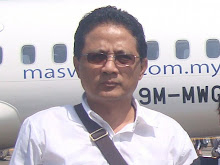Sunday, August 21, 2011
ASEAN at 44: Toward a solid community
Yoes Kenawas, Singapore | Sat, 08/20/2011 8:00 AM A | A | A |-Klipping the Jakarta Post.
This year the Association of Southeast Asian Nations (ASEAN) celebrates its 44th anniversary. Forty-four years of maintaining peace and stability in one of the most dynamic regions in the world is a remarkable achievement for an association that was built in the midst of the Cold War.
However, as the Cold War came to an end, the forces of globalization and interdependence became something inevitable for most countries around the world, including ASEAN member states.
Therefore, to strengthen its cooperation and cohesion, they have decided to go further beyond its original form.
ASEAN wants to make a solid community under the umbrella of the ASEAN Community, which consists of three pillars, namely: the ASEAN Economic Community (AEC); the ASEAN Political-Security Community (APSC); and the ASEAN Socio-Cultural Community (ASCC). The deadline set for the establishment of this new form of cooperation among Southeast Asian countries is 2015.
The ASCC Blueprint has stated that building an ASEAN identity is one of its objectives. Thus, the ASCC aims to promote awareness and common values within ASEAN to its people, as well as to create a sense of belonging, mutual understanding, and togetherness.
By doing so, ASEAN hopes that its citizens will give their full support toward the establishment of the ASEAN Community by 2015.
Citizens’ support is a vital precondition to establish a solid network and cooperation among ASEAN member countries. Without it, cooperation at the elite level will be “soulless” because their people, which are their ultimate reason to cooperate with each other, will not be aware of the benefits of such cooperation, leading to potential pessimism and skepticism among ASEAN’s populations about cooperation.
In short, without the support of citizens, cooperation among the governments of Southeast Asia will be less effective, if not useless.
One of the many ways by which this support can be obtained is via people-to-people contact.
People-to-people contact can bring strong support for ASEAN governments that want to form any kind of positive cooperation.
Through interactions, citizens in ASEAN countries can get to know each other better, build mutual understanding, develop the sense that they are facing common problems and, ultimately, seek for common solutions to their problems.
The latter issue is where governments can play a key role by cooperating with each other to create
common policies or programs, which can then be accepted and implemented by all members of ASEAN, reassured that such policies and programs will bring benefits to their people.
People-to-people interaction does not necessarily mean direct interaction (although it is the most effective way).
Indirect interaction through various channels, such as through mass media, online communities, or through social networking sites like Facebook and Twitter, can offer alternatives to bridging communication among the 600 million people across the region.
Interaction among ASEAN citizens is still minimal. And yet, there are a great many meetings, policies, and programs that have already been carried out with the aim to increase interaction between ASEAN citizens; for example, the ASEAN Ministerial Meeting on Youth (AMMY); the ASEAN Committee on Women; the ASEAN Education Ministers’ Meeting; the ASEAN Foundation’s programs; the ASCC Blueprint; free social visit visas for citizens of ASEAN countries (although not available in all member countries); and many other forms of cooperation.
In essence, ASEAN’s respective governments are trying their best to serve the needs of ASEAN people.
However, most Southeast Asians are still not aware about these meetings, policies and programs. The reason being, that there is no intensive news coverage on ASEAN issues or any intensive promotion and dissemination of information by the government to the general public.
With only four years left until 2015, people-to-people interaction to increase social cohesion among Southeast Asians needs to be accelerated. Otherwise, ASEAN Community 2015 will only emulate most ASEAN cooperation in the past, which is to say it starts and ends at the elite level while the people are left behind.
Some solutions can be suggested to foster people-to-people interaction in the region.
First, considering mass media is one of the most effective channels to disseminate information to broader audiences, the governments of Southeast Asia need to be more focused on efforts to embrace and engage with the mass media in ASEAN countries.
Thus, intensive, innovative, and integrated media relations programs need to be developed immediately. Intense engagement of the media could encourage media channels or the press community to write more about ASEAN.
Second, Southeast Asian governments need to increase the number of activities, such as youth exchanges and youth camps, teacher and lecturer exchanges, as well as other activities that could provide direct interaction among community leaders or opinion makers from ASEAN member states.
Those activities should be evaluated from time to time and networks that are built among the participants should be maintained.
Third, the governments of Southeast Asia need to provide more support to the non-governmental and private sectors’ efforts that can help promote people-to-people interaction across ASEAN.
If governments cannot support this interaction in terms of funding, they can at least facilitate and provide access to meet the needs of cooperation with partner institutions from other ASEAN countries.
Finally, ASEAN governments need to utilize the power of social media, such as Facebook, Twitter, LinkedIn, Flickr, and others, to generate support among ASEAN
populations.
These social media can be employed as the powerful tools they are for helping people to get to know each other better, exchange ideas, share experiences, and seek common solutions.
Hopefully, by 2015, ASEAN can establish a solid ASEAN Community with the full support of its citizens who share the same idea: “Think, feel, and act ASEAN”. Congratulations ASEAN.
The writer is a research analyst in the Indonesian Program at the Rajaratnam School of International Studies, Nanyang Technological University, Singapore.
Subscribe to:
Post Comments (Atom)

No comments:
Post a Comment